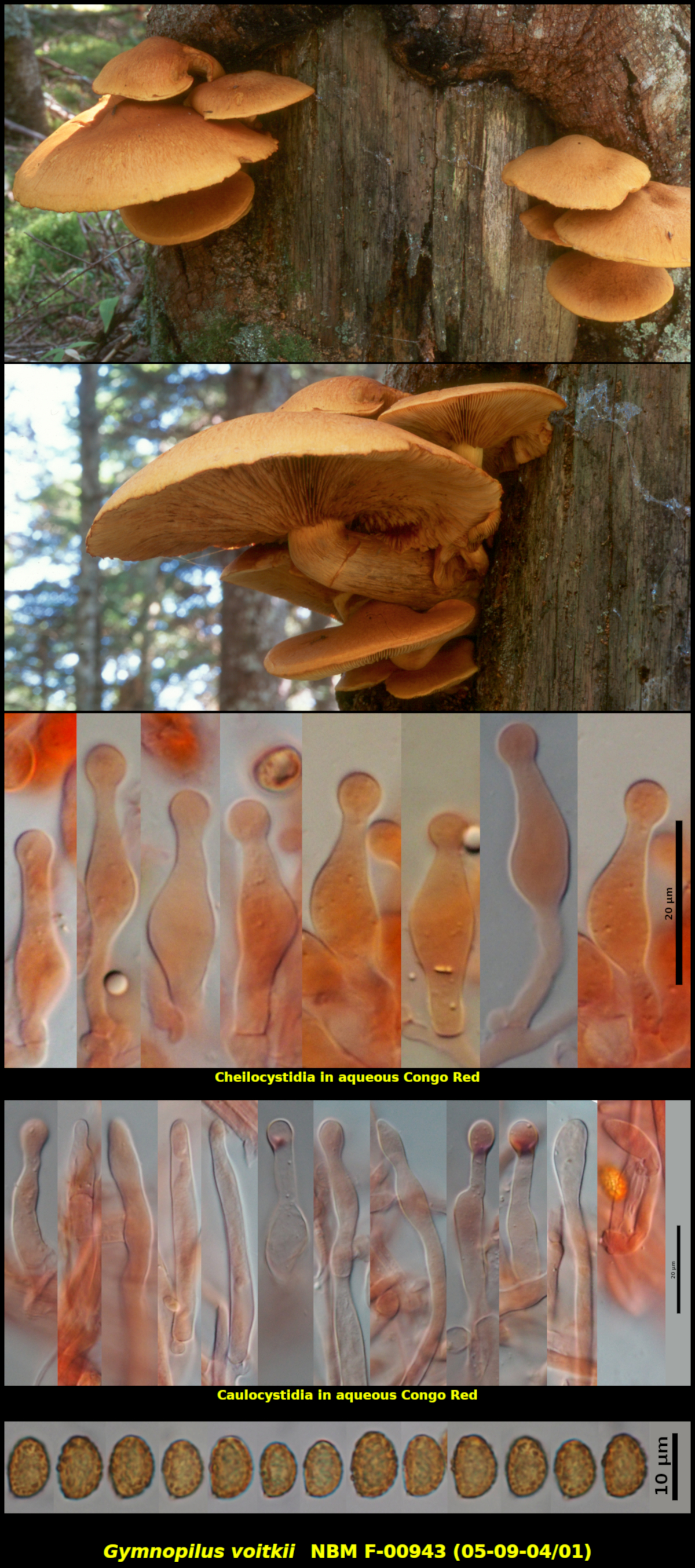Fleshy Fungi of New Brunswick >>
Gymnopilus voitkii
Gymnopilus voitkii Malloch & Thorn

Clustered (several) on an old wound at the base of the living trunk of Abies balsamea, Little Lepreau, New Brunswick (HOLOTYPE: NBM F-00943 [Malloch 22-08-12/02]).
Pileus conic-convex at first, expanding to broadly convex at maturity, with a low broad umbo or without an umbo, dry and with a matte and unreflective surface, glabrous to finely appressed-scaly, orange yellow to brownish orange, pale yellow below the surface tissues, sometimes with a submarginal fringe of veil remnants and then the annulus less well-defined, 27-155 mm in diameter. Stipe equal to clavate or ventricose, sometimes subradicating, dry, glabrous, greyish orange to brownish orange, 28-120 X 6-20 mm. Lamellae greyish yellow, slightly darker and developing some rusty stains in age, close to subclose, adnexed, not marginate. Partial veil forming a membranous and pendant annulus in some basidiomata but with this reduced to a cortinate annular ring in others, often appressed to the stipe in age. Flesh pale yellow, more orange toward the base of the stipe, often with a complex odour described as mushroom mixed with sweat, coconut or mint, very bitter in taste.
Basidiospores ellipsoidal, with broadly rounded apices, coarsely roughened with large and irregular warts, darkening in 5% KOH, non-dextrinoid to lightly dextrinoid, 7.9-9.9 x 5.6-6.9 μm, Q = 1.31-1.54 (average[691/22] = 8.9 x 6.2 μm, Q = 1.43). Cheilocystidia mostly lecythiform but occasionally without a swollen apex, 23.0-40.3 x 4.8-9.3 μm (average[183/11]: = 32 x 7.1 μm), with swollen head 3.7-7.1 μm in diameter (average = 5.4 μm). Pleurocystidia rare to absent, similar to the cheilocystidia but less strongly capitate. Caulocystidia abundant above the annular zone, produced as terminal cells of long hair-like hyphae, narrowly ventricose-capitate to cylindric-capitate, sometimes cylindrical and without significant apical swelling, 35-76 x 3.1-8.9 μm (average = 56 x 6.0 µm), with head 3.6-8.4 μm, (average = 6.0 μm). Basidia 4-spored, clavate to cylindrical, usually constricted near or above the middle, occasionally stipitate. Clamp connections present on nearly all septa.Gymnopilus voitkii is not a rare mushroom although it has not been recognized as distinct until quite recently (Thorn et al., Botany, 2020, 98(6): 293-315). It has been observed by collectors for decades but, using available keys, was always lumped in with G. junonius or G. spectabilis. DNA studies now reveal that the latter two species are unknown in North America and that other names need to be found for ones occurring here. Gymnopilus voitkii was named in honour of Dr. Andrus Voitk, a major contributor to mycology in Canada, especially Newfoundland and Labrador where G. voitkii is commonly found.
The most obvious field characteristic of G. voitkii is that it grows on the wood of conifers, particularly firs. Most related species are found on the wood of hardwood trees. It is common on this substrate in eastern Canada and northeastern USA and has been found as far south as the Great Smoky Mountains National Park in North Carolina. There are also two records from BC, raising the issue of confusing it with G. ventricosus, a species known from conifer wood all along the west coast of North America. The two species can be distinguished definitively by microscopic examination. Gymnopilus ventricosus has basidiospores with a more conical apex and cheilocystidia with weakly swollen apices. The basidiomata of G. ventricosus are usually larger than those of G. voitkii and have a more swollen stipe, but these features may easily overlap in the two species.
Photograph: D. Malloch NBM F-00943 [Malloch 22-08-12/02]).